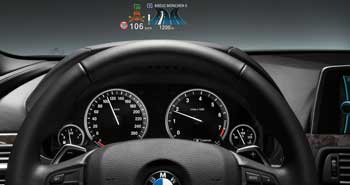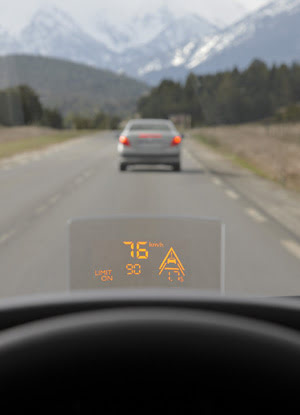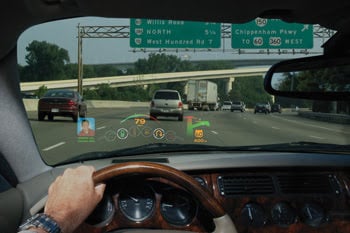
Head-Up Displays Keep Speed and More in Sight
Despite current issues, including cost, experts say projecting information on a windshield is a future safety must-have for drivers.
Keeping your eyes on the road could get easier, thanks to advances in automotive head-up displays, or HUDs.
They are becoming more capable, with color imagery depicting speed, lane location, turn direction, radio setting and other information. All of this data floats in front of the driver, at a distance that seems to be about the same as the front bumper.
It’s something that few have seen, although head-up displays have been around in cars from Detroit-based General Motors and other manufacturers for decades. Those who have driven these vehicles have been able to travel hundreds of miles without ever glancing down at the instrument panel, said Thomas Seder, a group manager in GM’s global research and development lab.

General Motors R&D and several universities are working on a head-up display system that will project data from several sensors on the entire surface of a windshield – highlighting, for instance, lanes in poor visibility conditions.
“We consistently find that people who experience HUDs never want to give them up,” he said.
Head-up displays are not currently found in every car for one very practical reason. “Primarily, it’s been a cost issue,” Seder said. “But we see HUDs in the future as a huge safety component.”
The increase in safety arises because drivers do not have to take their eyes off the road or even change their eyes’ focal distance much. Eliminating even a few seconds of distraction can pay off in accident prevention.
“The type of data that is displayed contains various functions aimed at enhancing road safety and, of course, driving comfort and direction,” said Monty Roberts, a spokesman for BMW of North America in Woodcliff Lake, N.J. The list includes speed, turn-by-turn directions, cruise control information, low tire pressure and “check oil” alerts. In various BMW models equipped with optional HUDs, all of this information appears in an ~7.75 x 4-in. area.

An optional head-up display from BMW shows speed and turn-by-turn directions.
The head-up display market will quadruple from $150 million today to $600 million by 2018, predicts Ben B. Scott, an automotive analyst with IMS Research. Still, the penetration rate among cars will be in the single digits, percentagewise.
“Amongst vehicles, it’s still going to be relatively small,” he said.
Cost is indeed among the barriers to widespread adoption of the technology, he added. Another is that, as head-up displays make their way from premium to more middle-of-the-road vehicles, automobile manufacturers will want to distinguish what is in a premium package from what is available in less expensive cars.
Therefore, the displays not only must become cheaper, but also have added capabilities, such as covering a larger
area or offering greater resolution.
Other analyst firms also see the expansion of head-up displays into less expensive cars. Including them as an option in less expensive cars would really drive the production volume up for such systems, said Satish Matade, a senior research analyst in semiconductors and electronics for MarketsandMarkets of Dallas. He added that it will be at least a few years before this happens.
“We estimate that HUDs in mid-segment cars will be down the road, around 2015,” he said.
The challenge will be pulling off this increase in deployment in a cost-effective manner. Head-up displays operate in a difficult environment, with variations in vibration, the elements, temperature and lighting conditions. Unlike a monitor or television, a windshield is a transparent screen with a background that can be dim during nighttime or brilliantly lit during the day. A final challenge is that everything in a head-up display must fit into limited space inside the dashboard.

Using a small, transparent screen, or a combiner, instead of a windshield could cut the cost of a head-up display, as seen in this Johnson Controls product installed as an option in a Peugeot.
The head-up display from Nippon Seiki of Nagaoka, Japan, which claims to be the world’s No. 1 manufacturer of the systems, uses an LED-backlit color thin-film transistor LCD to form the image. Light from this source bounces off two mirrors before ending up on the windshield with 480 x 240-pixel resolution.
The only way to overcome the varying lighting conditions and ensure enough contrast for the display to be clear is through intensity. Because of losses along the way, projecting that much light onto the windshield means that a lot of luminance must be present at the beginning.
“The LED power is huge. We drive the LEDs a lot. The intensity is greater than 10,000 candelas,” said Yoshi Ida, division manager of Nippon Seiki’s US design center, N.S. International Ltd. of Troy, Mich.
One consequence of producing so much luminance is heat, and the resulting need for a large heat sink makes the system bulky. A more efficient source would allow system size to shrink. Laser diodes are a possible solution, but the devices must meet automotive specifications. Thus, they must operate between –40 and 85 °C for years – and this is a tall order.
N.S. International is working on devices that use lasers, but their appearance in a head-up display is perhaps five years out, said Al Petrulis, director of North American sales and marketing.
“In between then and now, we’re trying to optimize intensities, colors, things of that sort,” Petrulis said.
The use of lasers in head-up displays received a significant boost not long ago, said Lance Evans, director of business development for automotive applications at MicroVision Inc. in Redmond, Wash.
The company’s products use a milli-meter-size microelectromechanical systems laser-scanning device to create a head-up display. The advent of a direct-emitting green laser diode cut the cost of the solution considerably and made it commercially competitive, Evans said.
The system paints the image point by point via a flying spot; the beholder’s persistence of vision knits the distinct points together into a picture. A key advantage of MicroVision’s approach is that the lasers produce very saturated colors, easily overcoming anything beyond the windshield.
“When we put green up or we put red up or we put magenta up, it really pops over the background,” Evans said.
MicroVision’s display technology is just entering the market, with the first volume product appearing this year in a system from Pioneer aimed at Japanese car buyers. Toward the end of the decade, head-up displays will be going into millions of cars annually worldwide, Evans predicts.
Other companies are tackling issues associated with the other end of the optical path: the surface used for head-up displays. Windshields have been the traditional choice, but they present problems.
Chief among them is that windshields are actually two pieces of glass with a polymer sandwiched in between. The most popular polymer creates spurious reflections when an image is projected onto it. The solution has been to use a different polymer, one that eliminates ghosting. Doing so, however, requires carrying two windshield types, complicating inventory management. Also, the windshield suited for a head-up display costs more than the other and, finally, a car that is getting a head-up display must get the correct windshield, too, making assembly more complex.
Johnson Controls of Milwaukee, an automotive component supplier, is attempting to cut the cost of head-up displays through the use of a combiner, a small transparent screen upon which an image is projected. The arrangement eliminates the need for an expensive windshield and allows a stand-alone system to go into a wider array of vehicles. Overall, it cuts the cost of a head-up display by about a third, as compared with the more traditional windshield-only approach, said Patrick Nebout, director of global driver information systems for the company.
The combiner product has been an option in Peugeot cars since late 2009, and drivers have been very accepting of it, Nebout said. It uses a backlit thin-film transistor LCD to form the image, but it could someday use lasers, provided they hit cost and performance targets.
As for what is being shown on the head-up display, that is likely to evolve with the technology. Today, drivers can
be distracted by the car’s instrument panel and its infotainment system, as well as by smartphones and tablets brought into the vehicle.

Head-up displays indicate an array of car data (center), navigation (right) and even incoming phone callers (left), as seen in this laser-source system from MicroVision.
A head-up display offers a way to accumulate information coming in from the Internet, the radio, the vehicle or a phone and to present the important elements to the driver. For instance, the display could alert a driver of an incoming call.
“Then you go on to key actions of the driver, either to reject the call or to accept the call,” Nebout said.
It’s important that this information presentation be designed to be useful but not distracting, he added. Achieving the right balance will take human factor studies and careful engineering.
The problem of possible distraction is something that concerns Tokyo-based Toyota Motor Corp., said Masaharu Hirota, general manager of the company’s electronics development department. Toyota is offering a head-up display option for its new Prius hybrid.
Although declining to speak about any specific future plans, Hirota did say that lasers are a promising technology for this application. Head-up displays in general fit into a desire to provide drivers with more information, but how to do this has not yet been settled, he added.
“As we need to keep the importance of preventing driver distraction in mind at all times, we are investigating different volumes and different methods” of providing information, Hirota said.
Published: September 2012